Nature-Based Solutions for Storm Water Management—Creation of a Green Infrastructure Suitability Map as a Tool for Land-Use Planning at the Municipal Level in the Province of Monza-Brianza (Italy)
Abstract
1. Introduction
2. Materials and Methods
2.1. Definition of the Information Needed (Phase I)
2.2. Production of the Base Maps (Phase II)
2.2.1. Map of Green Areas
- The land-use database “DUSAF”, produced by Lombardy Region;
- The topographic database “DBT”, produced by Lombardy Region and Municipalities;
- Maps contained in Municipal urban plans, produced by Municipalities.
- Agricultural, wooded and semi-natural areas;
- Urban green areas;
- Green areas connected to the transport network.
- Availability of data in shapefile format, including not only public green areas but also private green areas (i.e., annexed to residential areas, industrial areas etc.);
- Completeness of the data related to green cover;
- Up-to-date data (we preferred to use the most recent data).
2.2.2. Map of Natural Surface Infiltration Potential
2.2.3. Map of Exclusion Areas
- The Flood Risk Management Plan (PGRA) of the Po river basin, as established from the EU Floods Directive (60/2007);
- The Hydrogeological Plan of the Po river (PAI), provided by the Po river basin authority;
- A geological feasibility map of the municipal urban plan;
- A geological general map of the municipal urban plan.
3. Results
3.1. Green Area Compatibility Map to Realize the Green Infrastructure
- Naturalness score [Ns] = [N];
- Urban context score [Us] = [U];
- Anthropic presence score [As] = 5 − [A] + 1;
- Productive value score [Ps] = 5 − [P] + 1.
3.2. Weighting Procedure for Potential Infiltration and Exclusion Areas
3.3. Green Infrastructure Suitability Map
4. Discussion and Conclusions
4.1. Discussion
4.2. Conclusions
- An informative basis in the land-use planning process in order to set up or update the municipal plan (PGT) with reference to rainwater management, in accordance with the regulations of Lombardy Region;
- A necessary knowledge basis for the definition of municipal stormwater management plans, particularly related to the choice of the most appropriate NBS for each location.
Author Contributions
Funding
Institutional Review Board Statement
Informed Consent Statement
Data Availability Statement
Acknowledgments
Conflicts of Interest
Declaration
References
- Istituto Superiore per la Protezione e la Ricerca Ambientale. Qualità Dell’ambiente Urbano. IX Rapporto. Focus su Acque e Ambiente Urbano; ISPRA: Roma, Italy, 2013; ISBN 978-88-448-0622-4.
- Davis, M.; Naumann, S. Making the Case for Sustainable Urban Drainage Systems as a Nature-Based Solution to Urban Flooding. In Nature-Based Solutions to Climate Change Adaptation in Urban Areas. Theory and Practice of Urban Sustainability Transitions; Kabisch, N., Korn, H., Stadler, J., Bonn, A., Eds.; Springer: Cham, Switzerland, 2017; pp. 123–137. [Google Scholar] [CrossRef]
- Berndtsson, J.C. Green roof performance towards management of runoff water quantity and quality: A review. Ecol. Eng. 2010, 36, 351–360. [Google Scholar] [CrossRef]
- Guan, M.F.; Sillanpaa, N.; Koivusalo, H. Modelling and assessment of hydrological changes in a developing urban catchment. Hydrol. Process. 2015, 29, 2880–2894. [Google Scholar] [CrossRef]
- Yao, L.; Chen, L.D.; Wei, W. Assessing the effectiveness of imperviousness on stormwater runoff in micro urban catchments by model simulation. Hydrol. Process. 2016, 30, 1836–1848. [Google Scholar] [CrossRef]
- Fairbrass, A.; Jones, K.; McIntosh, A.; Yao, Z.; Malki-Epshtein, L.; Bell, S. Green Infrastructure for London: A Review of the Evidence. A Report by the Engineering Exchange for Just Space and the London Sustainability Exchange; Natural Environmental Research Council: London, UK, 2018. [Google Scholar]
- Chen, J.Q.; Theller, L.; Gitau, M.W.; Engel, B.A.; Harbor, J.M. Urbanization impacts on surface runoff of States the contiguous United States. J. Environ. Manag. 2017, 187, 470–481. [Google Scholar] [CrossRef]
- Du, J.; Qian, L.; Rui, H.; Zuo, T.; Zheng, D.; Xu, Y.; Xu, C.Y. Assessing the effects of urbanization on annual runoff and flood events using an integrated hydrological modeling system for Qinhuai River basin, China. J. Hydrol. 2012, 464, 127–139. [Google Scholar] [CrossRef]
- Valtanen, M.; Sillanpaa, N.; Setala, H. Effects of land use intensity on stormwater runoff and its temporal occurrence in cold climates. Hydrol. Process. 2014, 28, 2639–2650. [Google Scholar] [CrossRef]
- Yang, G.X.; Bowling, L.C.; Cherkauer, K.A.; Pijanowski, B.C. The impact of urban development on hydrologic regime from catchment to basin scales. Landsc. Urban Plan. 2011, 103, 237–247. [Google Scholar] [CrossRef]
- Tao, W.D.; Bays, J.S.; Meyer, D.; Smardon, R.C.; Levy, Z.F. Constructed wetlands for treatment of combined sewer overflow in the US: A review of design challenges and application status. Water 2014, 6, 3362–3385. [Google Scholar] [CrossRef]
- Chocat, B.; Ashley, R.; Marsalek, J.; Matos, M.R.; Rauch, W.; Schilling, W.; Urbonas, B. Toward the sustainable management of urban storm-water. Indoor Built Environ. 2007, 16, 273–285. [Google Scholar] [CrossRef]
- European Union. Nature-Based Solutions for Climate Mitigation. Analysis of EU-Funded Projects; European commission: Bruxelles, Belgium, 2020; ISBN 978-92-76-18200-9. [Google Scholar] [CrossRef]
- Fletcher, T.D.; Shuster, W.; Hunt, W.F.; Ashley, R.; Butler, D.; Arthur, S.; Trowsdale, S.; Barraud, S.; Semadeni-Davies, A.; Bertrand-Krajewski, J.; et al. SUDS, LID, BMPs, WSUD and more—The evolution and application of terminology surrounding urban drainage. Urban Water J. 2015, 12, 525–542. [Google Scholar] [CrossRef]
- Zhou, Q. A Review of Sustainable Urban Drainage Systems Considering the Climate Change and Urbanization Impacts. Water 2014, 6, 976–992. [Google Scholar] [CrossRef]
- Keeler, B.L.; Hamel, P.; McPhearson, T.; Hamann, M.H.; Donahue, M.L.; Meza Prado, K.A.; Arkema, K.K.; Bratman, G.N.; Brauman, K.A.; Finlay, J.C.; et al. Social-ecological and technological factors moderate the value of urban nature. Nat. Sustain. 2019, 2, 29–38. [Google Scholar] [CrossRef]
- European Union. Nature-Based Solutions: State of the Art in EU-Funded Projects; European commission: Bruxelles, Belgium, 2020; ISBN 978-92-76-17334-2. [Google Scholar] [CrossRef]
- Senes, G.; Fumagalli, N.; Ferrario, P.S.; Rovelli, R.; Sigon, R. Definition of a land quality index to preserve the best territories from future land take. An application to a study area in Lombardy (Italy). J. Agric. Eng. 2020, 51, 43–55. [Google Scholar] [CrossRef]
- US Environmental Protection Agency. Low Impact Development (LID). A Literature Review; EPA Office of Water (4203): Washington, DC, USA, 2000.
- Ashley, R.; Illman, S.; Kellagher, R.; Scott, T.; Udale-Clarke, H.; Wilson, S.; Woods Ballard, B. The SuDS Manual; CIRIA: London, UK, 2015. [Google Scholar]
- Walmsley, A. Greenways and the making of urban form. Landsc. Urban Plan. 1995, 33, 81–127. [Google Scholar] [CrossRef]
- European Union. Building a Green Infrastructure for Europe; European Commission: Bruxelles, Belgium, 2013; ISBN 978-92-79-33428-3. [Google Scholar] [CrossRef]
- Lähde, E.; Khadka, A.; Tahvonen, O.; Kokkonen, T. Can We Really Have It All?—Designing Multifunctionality with Sustainable Urban Drainage System Elements. Sustainability 2019, 11, 1854. [Google Scholar] [CrossRef]
- Dhakal, K.P.; Chevalier, L.R. Urban stormwater governance: The need for a paradigm shift. Environ. Manag. 2016, 57, 1112–1124. [Google Scholar] [CrossRef]
- Vogel, J.R.; Moore, T.L.; Coffman, R.R.; Rodie, S.N.; Hutchinson, S.L.; McDonough, K.R.; McLemore, A.J.; McMaine, J.T. Critical Review of Technical Questions Facing Low Impact Development and Green Infrastructure: A Perspective from the Great Plains. Water Environ. Res. 2015, 87, 849–862. [Google Scholar] [CrossRef]
- Pappalardo, V.; Campisano, A.; Martinico, F.; Modica, C.; Barbarossa, L. A hydraulic invariance-based methodology for the implementation of storm-water release restrictions in urban land use master plans. Hydrol. Process. 2017, 31, 4046–4055. [Google Scholar] [CrossRef]
- Christman, Z.; Meenar, M.; Mandarano, L.; Hearing, K. Prioritizing Suitable Locations for Green Stormwater Infrastructure Based on Social Factors in Philadelphia. Land 2018, 7, 145. [Google Scholar] [CrossRef]
- Charlesworth, S.; Warwick, F.; Lashford, C. Decision-Making and Sustainable Drainage: Design and Scale. Sustainability 2016, 8, 782. [Google Scholar] [CrossRef]
- Charlesworth, S.M.; Warwick, F. Sustainable drainage, green and blue infrastructure in urban areas. In Sustainable Water Engineering; Charlesworth, S.M., Booth, C., Adeyeye, K., Eds.; Elsevier: Amsterdam, The Netherlands, 2020; pp. 185–206. ISBN 9780128161203. [Google Scholar] [CrossRef]
- Wang, X.; Shuster, W.; Pal, C.; Buchberger, S.; Bonta, J.; Avadhanula, K. Low Impact Development Design—Integrating Suitability Analysis and Site Planning for Reduction of Post-Development Stormwater Quantity. Sustainability 2010, 2, 2467–2482. [Google Scholar] [CrossRef]
- Li, L.; Uyttenhove, P.; Vaneetvelde, V. Planning green infrastructure to mitigate urban surface water flooding risk—A methodology to identify priority areas applied in the city of Ghent. Landsc. Urban Plan. 2020, 194, 103703. [Google Scholar] [CrossRef]
- Yau, W.K.; Radhakrishnan, M.; Liong, S.Y.; Zevenbergen, C.; Pathirana, A. Effectiveness of ABC waters design features for runoff quantity control in Urban Singapore. Water 2017, 9, 577. [Google Scholar] [CrossRef]
- Dagenais, D.; Thomas, I.; Paquette, S. Siting green stormwater infrastructure in a neighbourhood to maximise secondary benefits: Lessons learned from a pilot project. Landsc. Res. 2017, 42, 195–210. [Google Scholar] [CrossRef]
- Pappalardo, V.; La Rosa, D.; Campisano, A.; La Greca, P. The potential of green infrastructure application in urban runoff control for land use planning: A preliminary evaluation from a southern Italy case study. Ecosyst. Serv. 2017, 26, 345–354. [Google Scholar] [CrossRef]
- Sun, Y.; Tong, S.; Yang, Y.J. Modeling the cost-effectiveness of stormwater best management practices in an urban watershed in Las Vegas Valley. Appl. Geogr. 2016, 76, 49–61. [Google Scholar] [CrossRef]
- Muthanna, T.M.; Sivertsen, E.; Kliewer, D.; Jotta, L. Coupling field observations and Geographical Information System (GIS)-based analysis for improved Sustainable Urban Drainage Systems (SUDS) performance. Sustainability 2018, 10, 4683. [Google Scholar] [CrossRef]
- Gallagher, K.V.; Alsharif, K.; Tsegaye, S.; Van Beynen, P. A new approach for using GIS to link infiltration BMPs to Groundwater Pollution Risk. Urban Water J. 2018, 15, 847–857. [Google Scholar] [CrossRef]
- Kuller, M.; Bach, P.M.; Ramirez-Lovering, D.; Deletic, A. What drives the location choice for water sensitive infrastructure in Melbourne, Australia? Landsc. Urban Plan. 2018, 175, 92–101. [Google Scholar] [CrossRef]
- Martin-Mikle, C.J.; de Beurs, K.M.; Julian, J.P.; Mayer, P.M. Identifying priority sites for low impact development (LID) in a mixed-use watershed. Landsc. Urban Plan. 2015, 140, 29–41. [Google Scholar] [CrossRef]
- Gregory, J.H.; Dukes, M.D.; Jones, P.H.; Miller, G.L. Effect of urban soil compaction on infiltration rate. J. Soil Water Conserv. 2006, 61, 117–124. [Google Scholar]
- Tredway, J.C.; Havlick, D.G. Assessing the Potential of Low-Impact Development Techniques on Runoff and Streamflow in the Templeton Gap Watershed, Colorado. Profess. Geogr. 2017, 69, 372–382. [Google Scholar] [CrossRef]
- Tsegaye, S.; Singleton, T.L.; Koeser, A.K.; Lamb, D.S.; Landry, S.M.; Lu, S.; Barber, J.B.; Hilbert, D.R.; Hamilton, K.O.; Northrop, R.J.; et al. Transitioning from gray to green (G2G)—A green infrastructure planning tool for the urban forest. Urban For. Urban Green. 2018, 40, 204–214. [Google Scholar] [CrossRef]
- Surma, M. Sustainable urban development through an application of green infrastructure in district scale—A case study of Wrocław (Poland). J. Water Land Dev. 2015, 25, 3–12. [Google Scholar] [CrossRef]
- Foomani, M.S.; Malekmohammadi, B. Site selection of sustainable urban drainage systems using fuzzy logic and multi-criteria decision-making. Water Environ. J. 2019, 34, 584–599. [Google Scholar] [CrossRef]
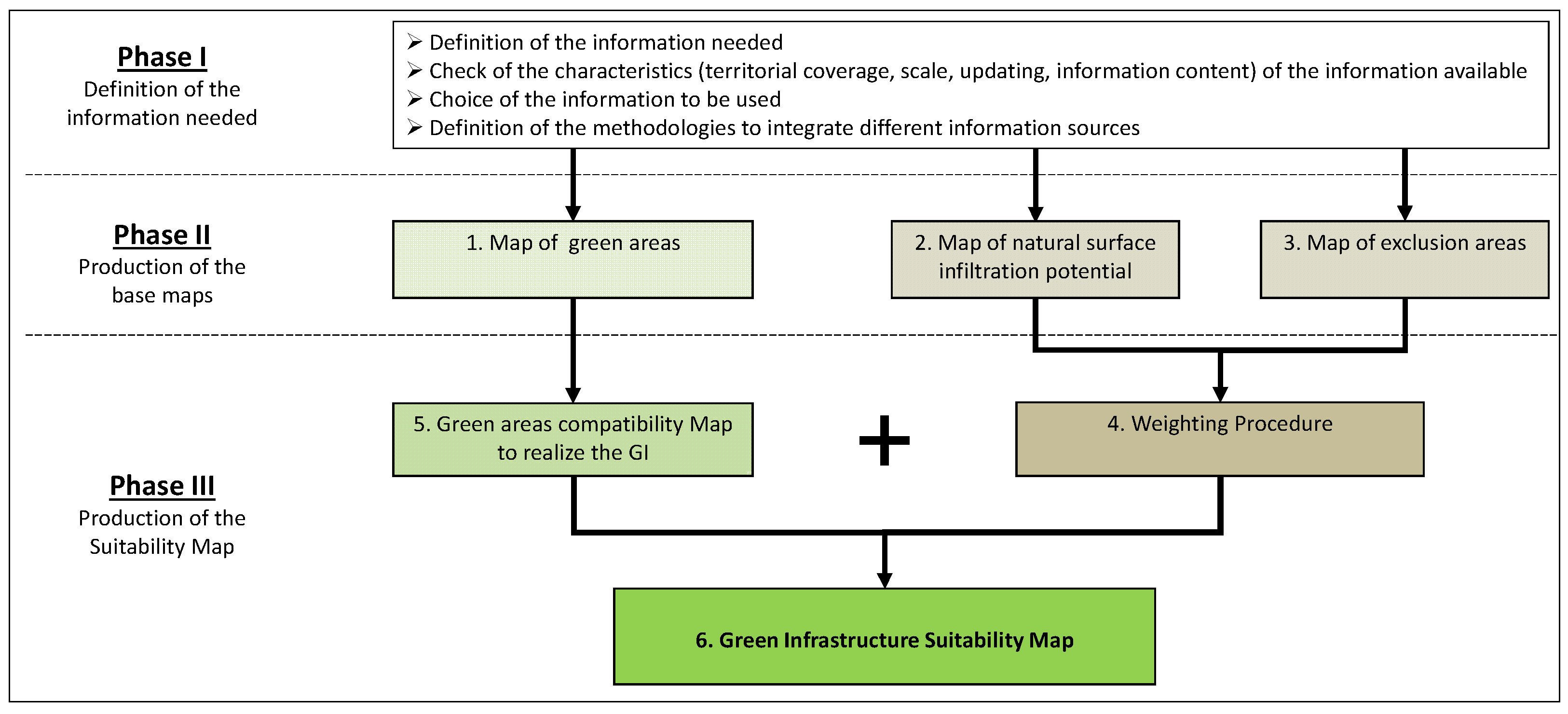
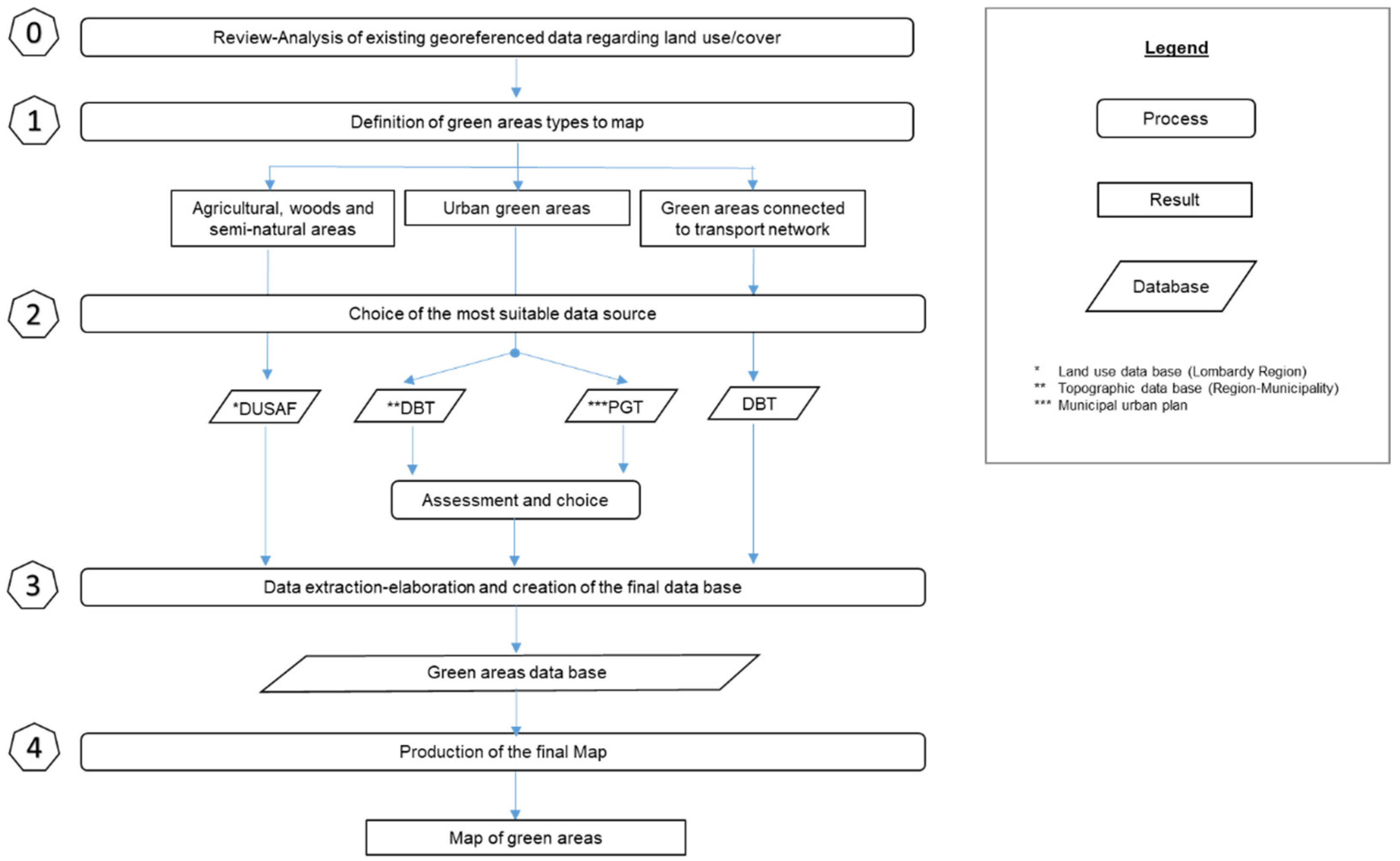
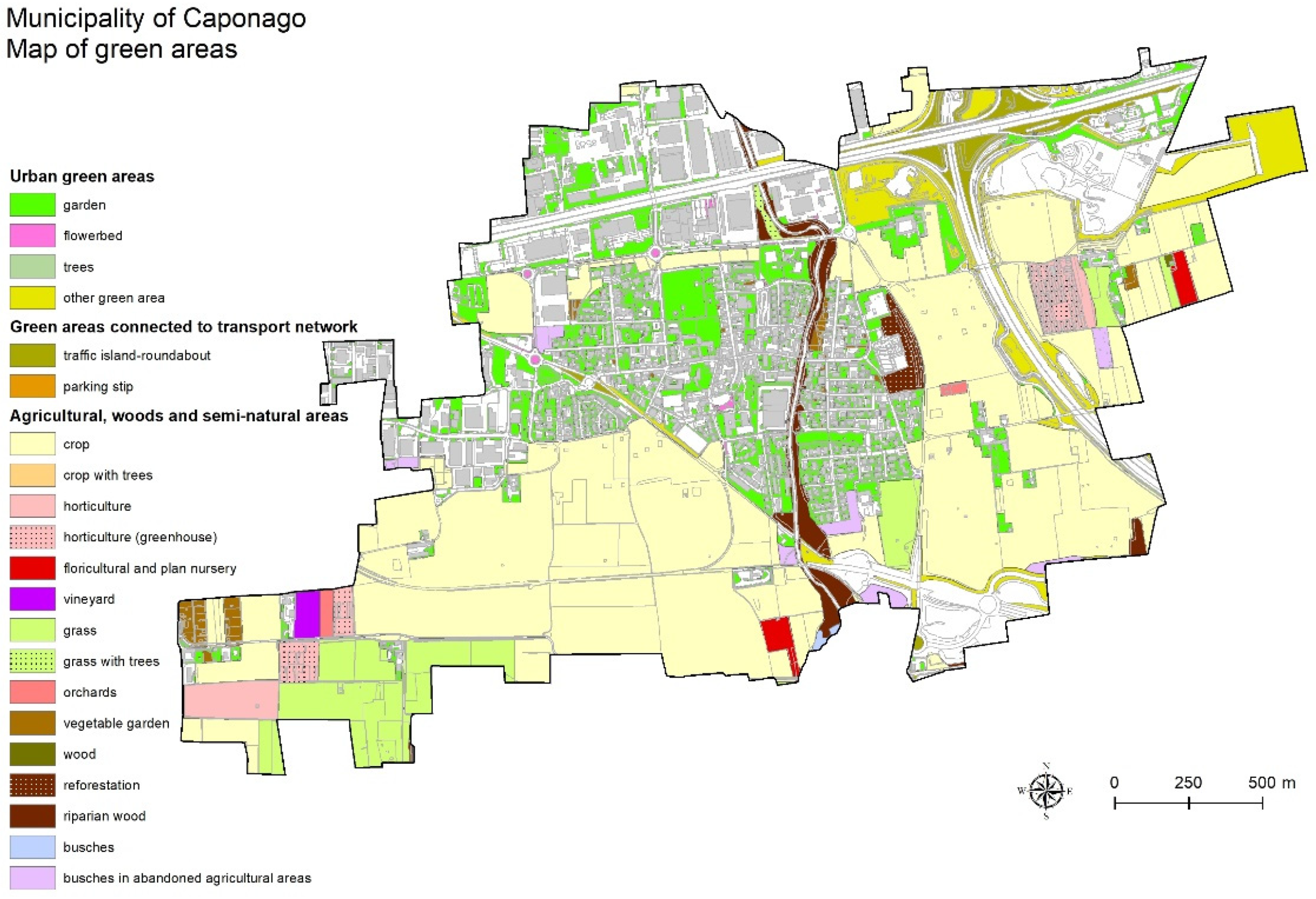
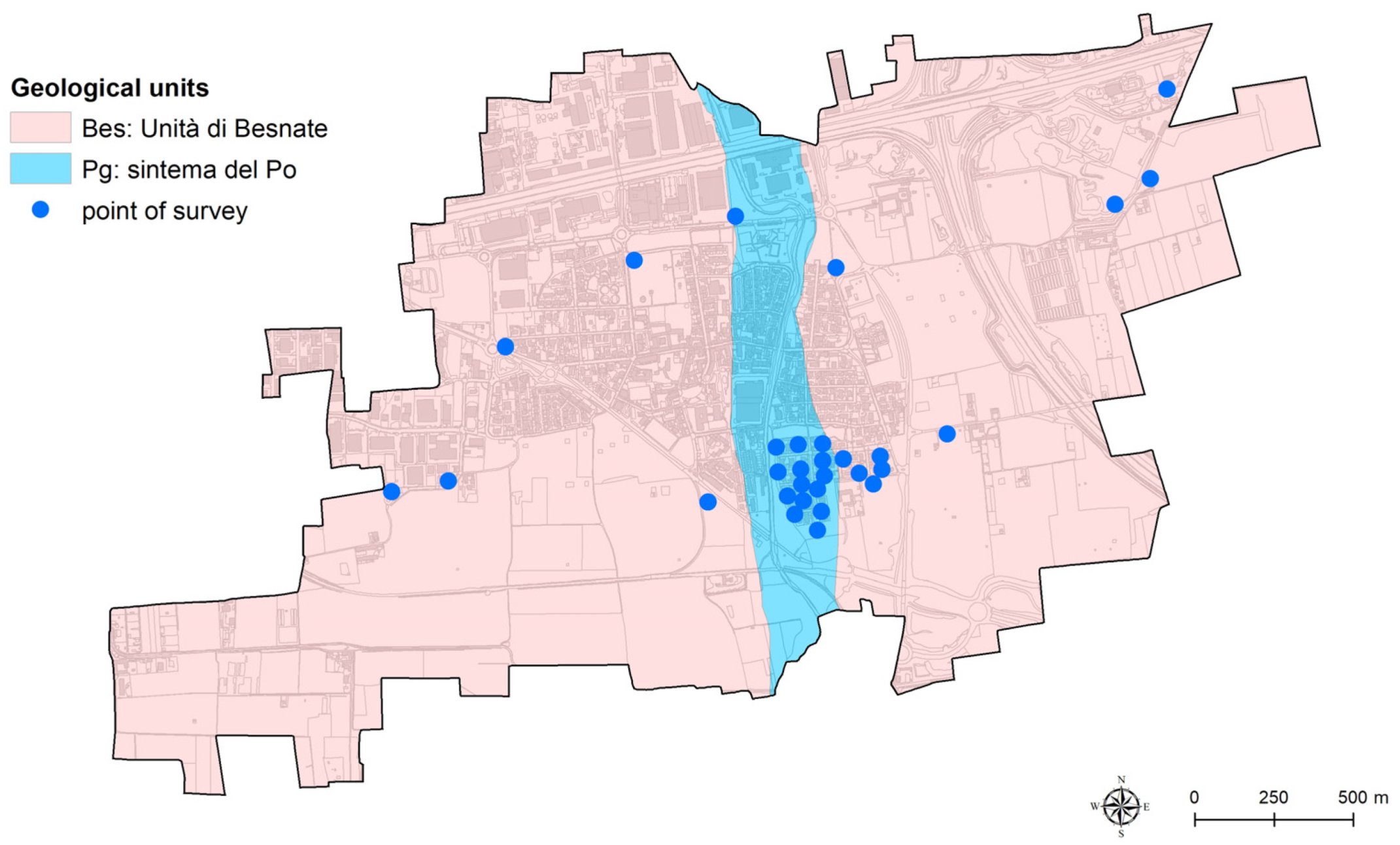
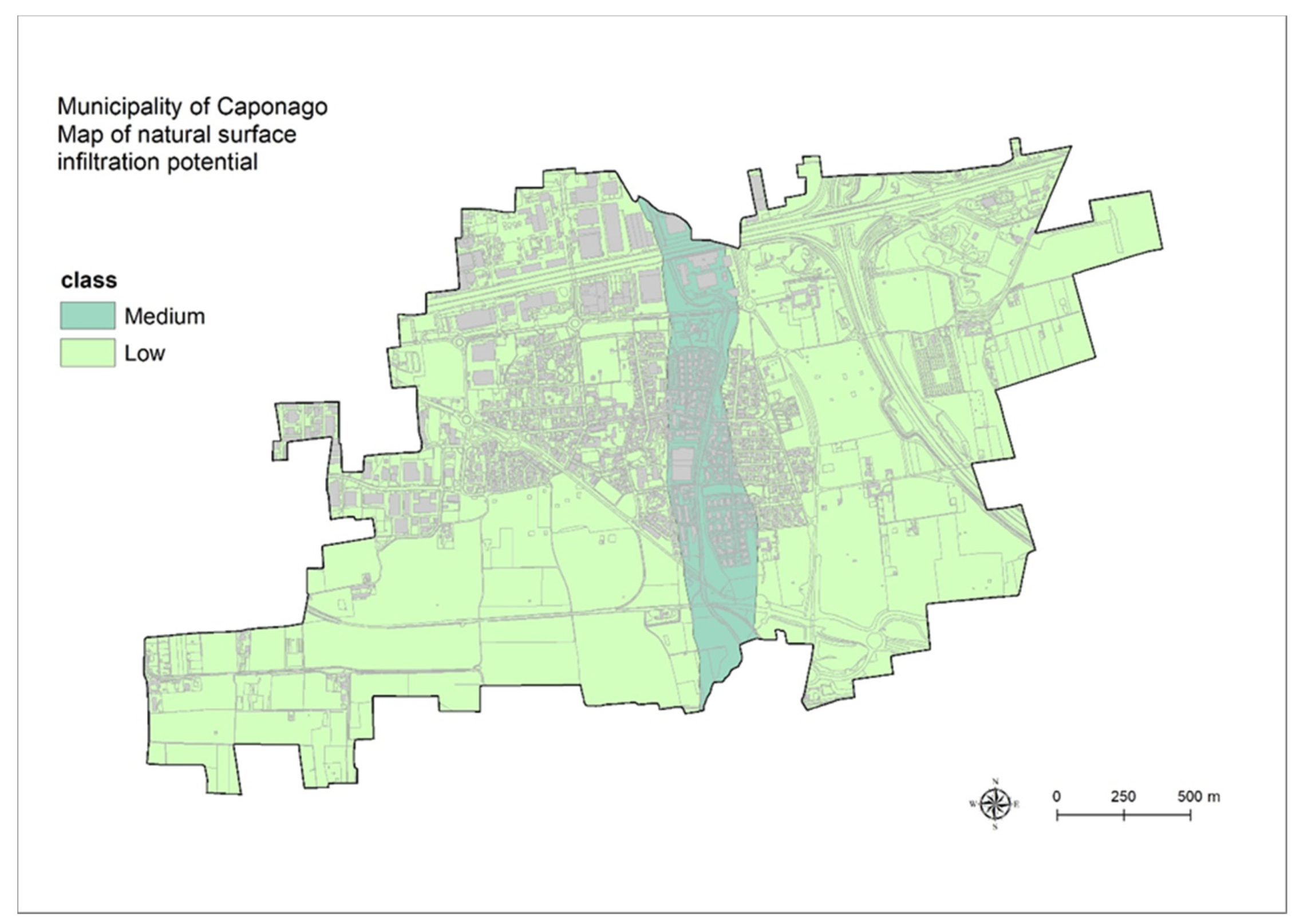
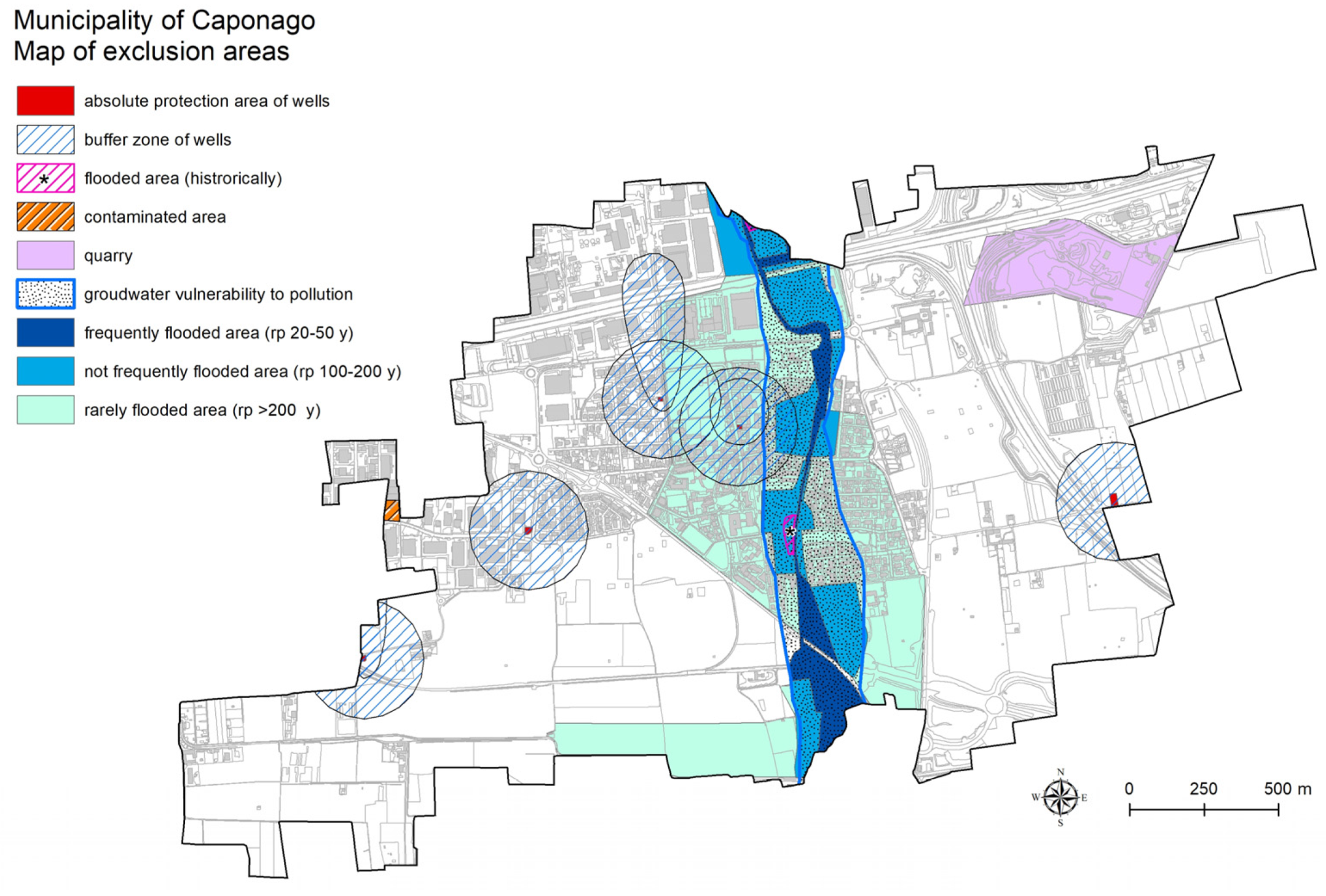
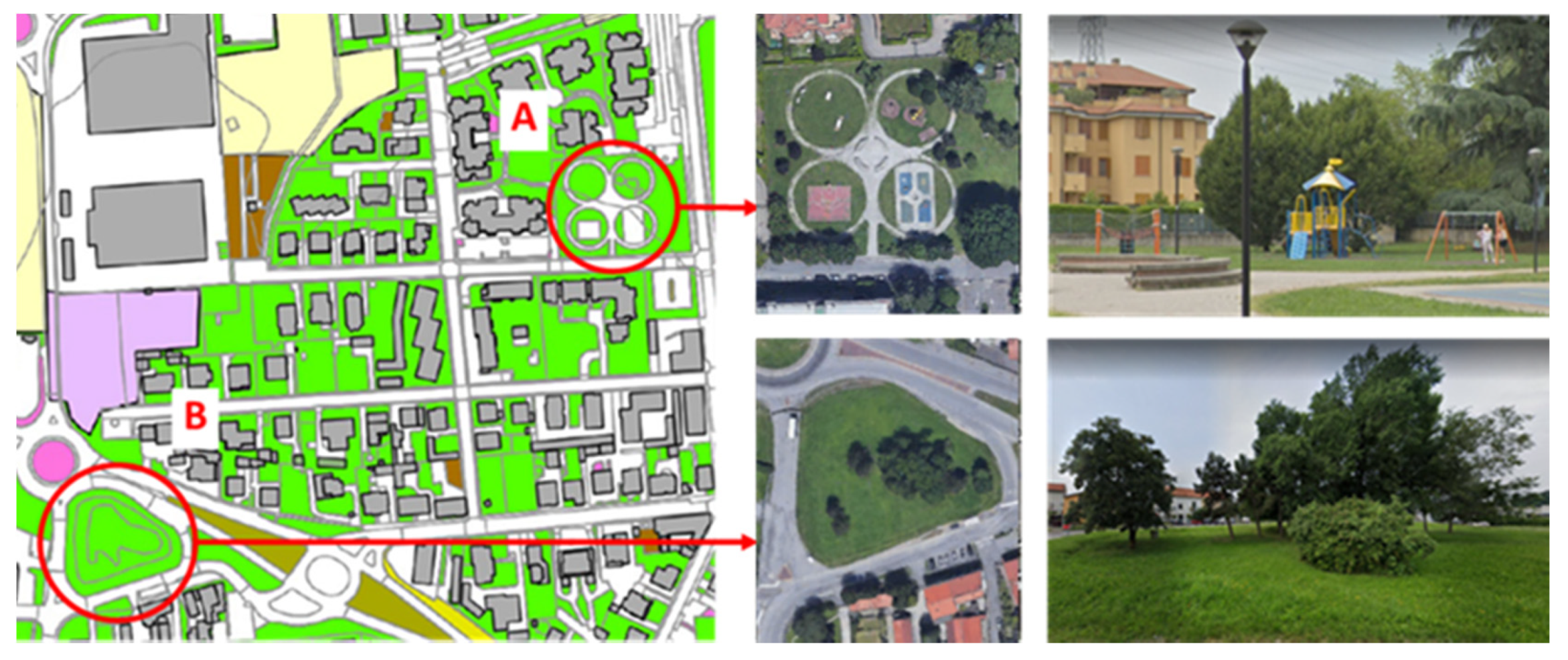
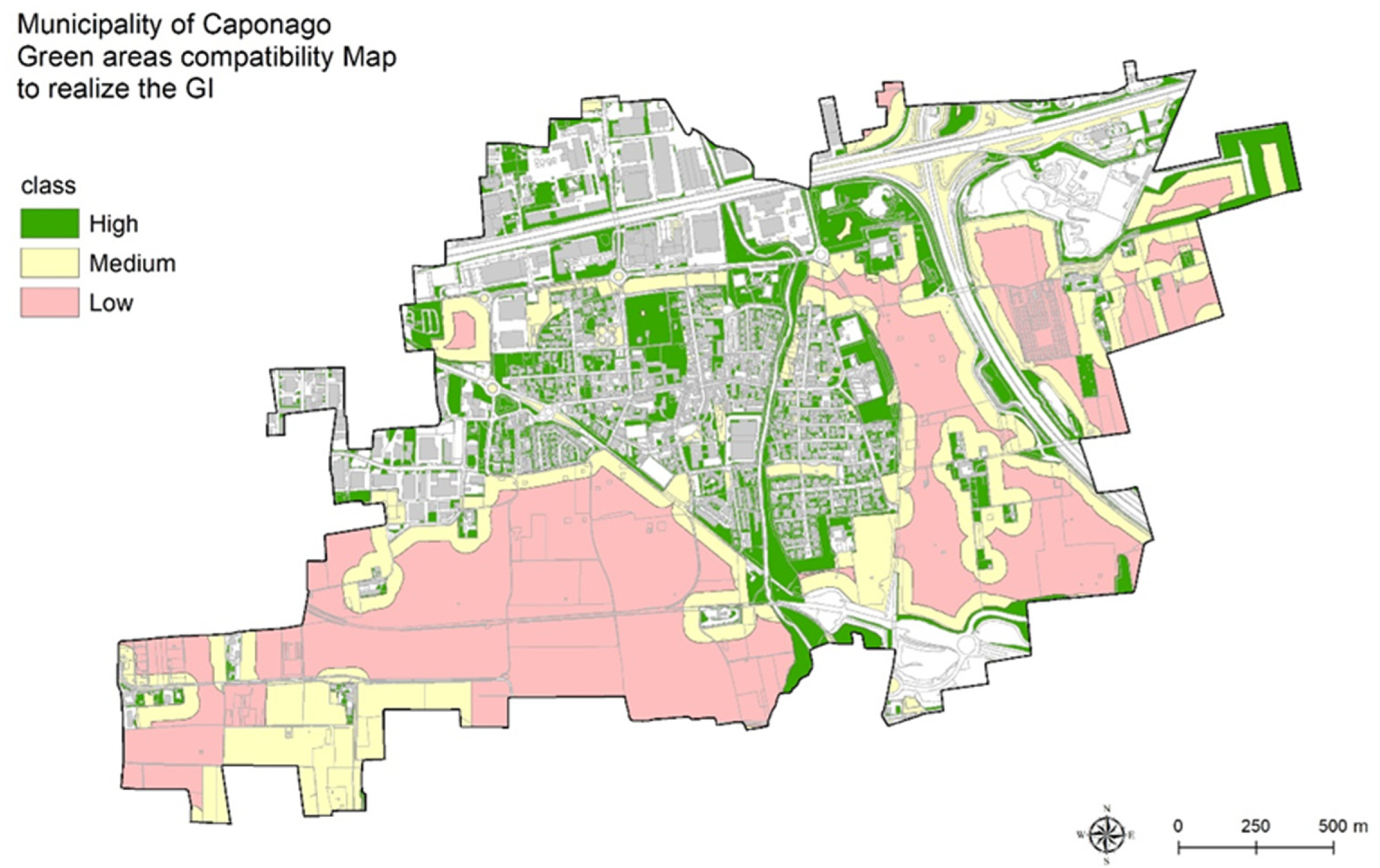
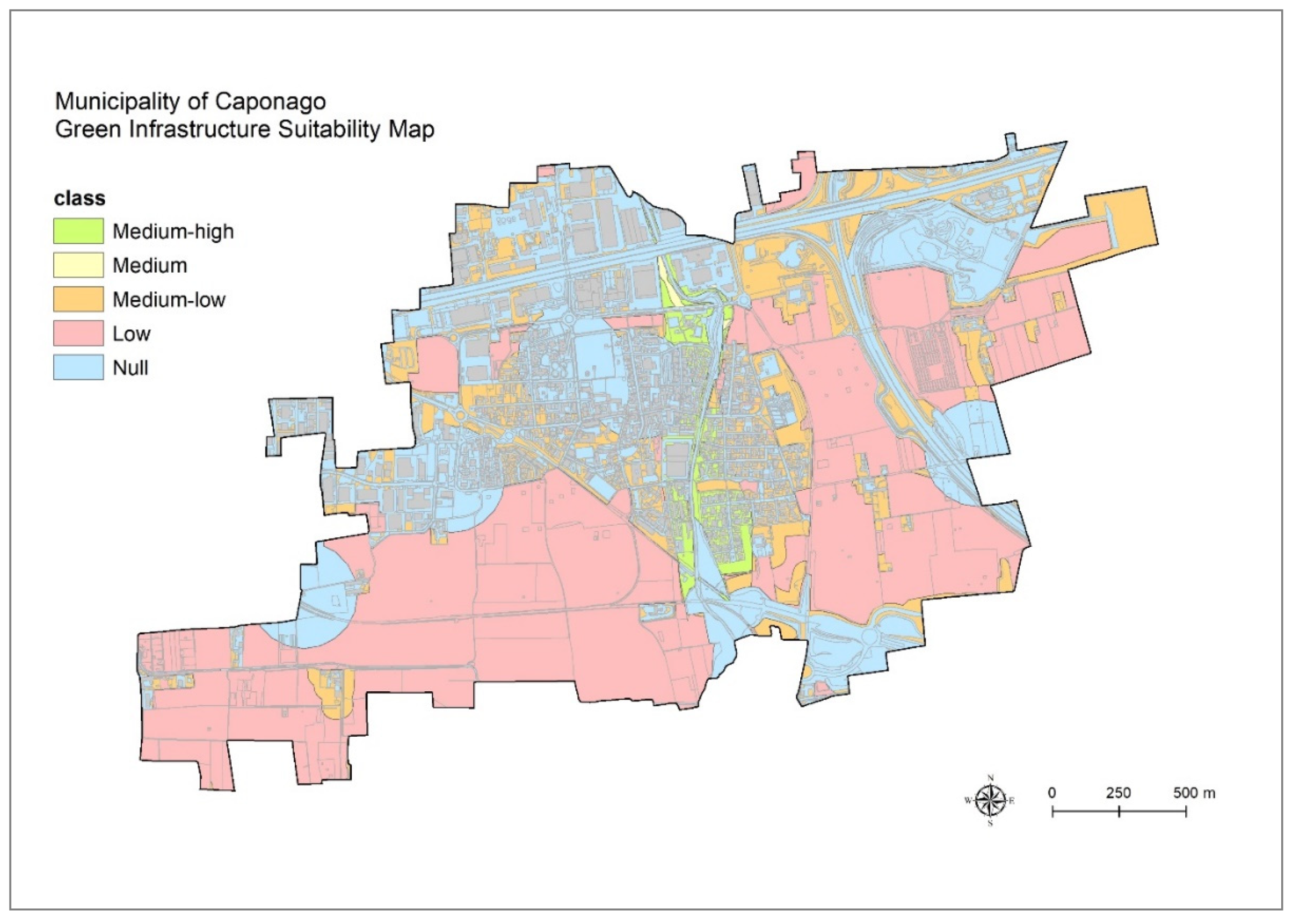
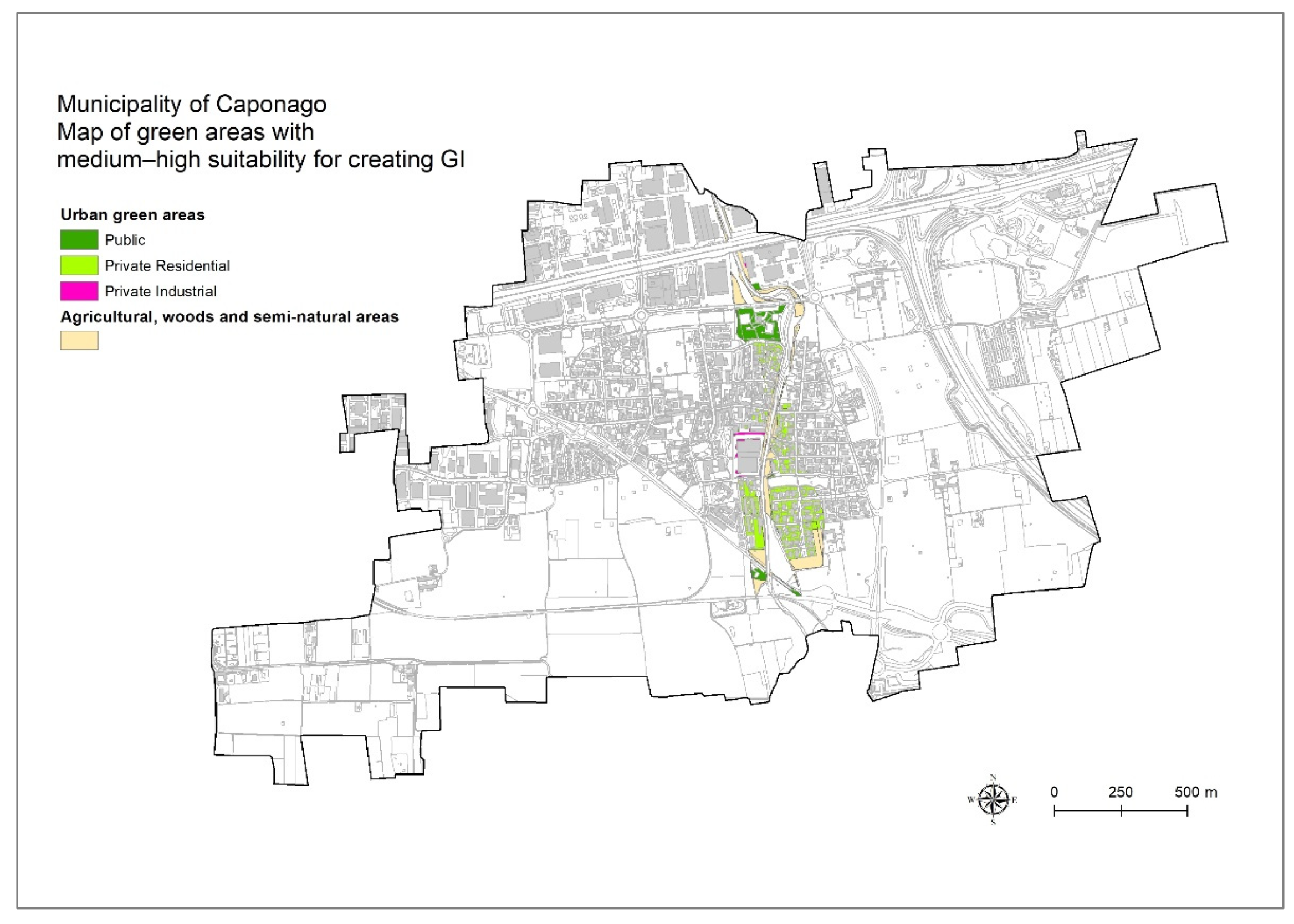
| Urban Green Area Conditions | PGT | DBT |
|---|---|---|
| Availability | no | yes |
| Completeness | no | yes |
| Update | yes | yes |
| Class | Type |
|---|---|
| Urban green areas | garden |
| flowerbed | |
| trees | |
| other green area | |
| Green areas connected to transport network | traffic island/roundabout |
| parking strip | |
| Agricultural, wooded and semi-natural areas | crop |
| crop with trees | |
| horticultural | |
| horticultural (greenhouse) | |
| floricultural and plant nursery | |
| vineyard | |
| grassland | |
| grassland with trees | |
| orchard | |
| vegetable garden | |
| deciduous wood | |
| reforestation | |
| riparian wood | |
| bushes | |
| bushes in abandoned agricultural lands |
| Geological Unit | CARG Code | Description |
|---|---|---|
| Unità di Besnate | Bes | Fluvioglacial and glacial deposits, slightly weathered, up to 4 m. Sporadic Loess deposits. |
| Sintema del Po | Pg | Gravels, sands and silts from recent fluvial deposits, lacustrine deposits, slope and colluvial deposits, landslide deposits. Fresh upper surface, characterized by entisols and inceptisols. |
| Classes of Surface Infiltration Potential | Reference Values of Saturated Hydraulic Conductivity (m/s) |
|---|---|
| Very high | >10−2 |
| High | 10−2–10−3 |
| Medium | 10−3–10−4 |
| Low | 10−4–10−5 |
| Very low | <10−5 |
| Geological Unit | CARG Code | Surface Potential Infiltration Class |
|---|---|---|
| Unità di Besnate | Bes | Low |
| Sintema del Po | Pg | Medium |
| Type of Green Area | Value of the Characteristic | Compatibility Score | ||||||||
|---|---|---|---|---|---|---|---|---|---|---|
| Naturalness [N] | Ant. Pres. [A] | Prod. Value [P] | Urban Context [U] | Naturalness = [N] | Ant. Pres. [=(5 − A) + 1] | Prod. Value [=(5 − P) + 1] | Urban Context [=U] | Total Score | Compatibility Class | |
| Equipped green area | 1 | 5 | 1 | 5 | 1 | 1 | 5 | 5 | 12 | M |
| Garden | 4 | 1 | 1 | 1 | 4 | 5 | 5 | 1 | 15 | M |
| Garden in urban context (uc) | 4 | 1 | 1 | 5 | 4 | 5 | 5 | 5 | 19 | H |
| Trees | 4 | 1 | 1 | 1 | 4 | 5 | 5 | 1 | 15 | M |
| Trees uc | 4 | 1 | 1 | 5 | 4 | 5 | 5 | 5 | 19 | H |
| Other green area | 4 | 1 | 1 | 1 | 4 | 5 | 5 | 1 | 15 | M |
| Other green area uc | 4 | 1 | 1 | 5 | 4 | 5 | 5 | 5 | 19 | H |
| Flowerbed | 1 | 2 | 1 | 1 | 1 | 4 | 5 | 1 | 11 | M |
| Flowerbed uc | 1 | 2 | 1 | 5 | 1 | 4 | 5 | 5 | 15 | M |
| Traffic island/roundabout | 1 | 2 | 1 | 1 | 1 | 4 | 5 | 1 | 11 | M |
| Traffic island/roundabout uc | 1 | 2 | 1 | 5 | 1 | 4 | 5 | 5 | 15 | M |
| Parking strip | 1 | 5 | 1 | 1 | 1 | 1 | 5 | 1 | 8 | L |
| Parking strip uc | 1 | 5 | 1 | 5 | 1 | 1 | 5 | 5 | 12 | M |
| Floricultural and plant nursery | 1 | 5 | 5 | 1 | 1 | 1 | 1 | 1 | 4 | L |
| Floricultural and plant nursery uc | 1 | 5 | 5 | 5 | 1 | 1 | 1 | 5 | 8 | L |
| Horticultural | 1 | 5 | 5 | 1 | 1 | 1 | 1 | 1 | 4 | L |
| Horticultural uc | 1 | 5 | 5 | 5 | 1 | 1 | 1 | 5 | 8 | L |
| Horticultural (greenhouse) | 1 | 5 | 5 | 1 | 1 | 1 | 1 | 1 | 4 | L |
| Horticultural (greenhouse) uc | 1 | 5 | 5 | 5 | 1 | 1 | 1 | 5 | 8 | L |
| Vegetable garden | 2 | 3 | 3 | 1 | 2 | 3 | 3 | 1 | 9 | L |
| Vegetable garden uc | 2 | 3 | 3 | 5 | 2 | 3 | 3 | 5 | 13 | M |
| Crop | 2 | 3 | 4 | 1 | 2 | 3 | 2 | 1 | 8 | L |
| Crop uc | 2 | 3 | 4 | 5 | 2 | 3 | 2 | 5 | 12 | M |
| Crop with trees | 3 | 2 | 3 | 1 | 3 | 4 | 3 | 1 | 11 | M |
| Crop with trees uc | 3 | 2 | 3 | 5 | 3 | 4 | 3 | 5 | 15 | M |
| Orchard | 2 | 3 | 5 | 1 | 2 | 3 | 1 | 1 | 7 | L |
| Orchard uc | 2 | 3 | 5 | 5 | 2 | 3 | 1 | 5 | 11 | M |
| Vineyard | 2 | 3 | 5 | 1 | 2 | 3 | 1 | 1 | 7 | L |
| Vineyard uc | 2 | 3 | 5 | 5 | 2 | 3 | 1 | 5 | 11 | M |
| Grassland | 3 | 2 | 3 | 1 | 3 | 4 | 3 | 1 | 11 | M |
| Grassland uc | 3 | 2 | 3 | 5 | 3 | 4 | 3 | 5 | 15 | M |
| Grassland with trees | 4 | 2 | 2 | 1 | 4 | 4 | 4 | 1 | 13 | M |
| Grassland with trees uc | 4 | 2 | 2 | 5 | 4 | 4 | 4 | 5 | 17 | H |
| Deciduous wood | 4 | 2 | 2 | 1 | 4 | 4 | 4 | 1 | 13 | M |
| Deciduous wood uc | 4 | 2 | 2 | 5 | 4 | 4 | 4 | 5 | 17 | H |
| Reforestation | 4 | 2 | 2 | 1 | 4 | 4 | 4 | 1 | 13 | M |
| Reforestation uc | 4 | 2 | 2 | 5 | 4 | 4 | 4 | 5 | 17 | H |
| Riparian wood | 5 | 1 | 1 | 1 | 5 | 5 | 5 | 1 | 16 | H |
| Riparian wood uc | 5 | 1 | 1 | 5 | 5 | 5 | 5 | 5 | 20 | H |
| Bushes | 5 | 1 | 1 | 1 | 5 | 5 | 5 | 1 | 16 | H |
| Bushes uc | 5 | 1 | 1 | 5 | 5 | 5 | 5 | 5 | 20 | H |
| Bushes in abandoned agricultural lands | 5 | 1 | 1 | 1 | 5 | 5 | 5 | 1 | 16 | H |
| Bushes in abandoned agricultural land uc | 5 | 1 | 1 | 5 | 5 | 5 | 5 | 5 | 20 | H |
| Potential Infiltration [PI] | Saturated Hydraulic Conductivity (m/s) | Weight [WPI] |
| High | 10−2–10−3 | 1.0 |
| Medium | 10−3–10−4 | 0.7 |
| Low | 10−4–10−5 | 0.5 |
| Very low | <10−5 | 0.1 |
| Exclusion Areas [EA] | Weight [WEA] | |
| Absolute protection area of wells, buffer zone of wells, flooded area, contaminated area, quarry, frequently flooded areas (return period of 20–50 years) | 0.0 | |
| Not frequently flooded areas (return period of 100–200 years), rarely flooded areas (return period of p > 200 years), groundwater vulnerability to pollution | 1 | |
| Score of [GI-Suit] | Classes of Green Infrastructure Suitability |
|---|---|
| 0 | Null |
| 1–7 | Low |
| 7–10 | Medium–Low |
| 10–13 | Medium |
| 13–15 | Medium–High |
| 16–20 | High |
| Green Area Class | Area (ha) | % of ma | % of tga |
|---|---|---|---|
| Agricultural, wooded and semi-natural areas | 254.60 | 50.74 | 75.42 |
| Green areas connected to the transport network | 7.07 | 1.41 | 2.09 |
| Urban green areas | 75.89 | 15.13 | 22.48 |
| Total | 337.56 | 67.28 | 100.00 |
| Class of Green Area | High Compatibility | Medium Compatibility | Low Compatibility | ||||||
|---|---|---|---|---|---|---|---|---|---|
| ha | % of ma | % of tga | ha | % of ma | % of tga | ha | % of ma | % of tga | |
| Agric., wooded and semi-natural | 16.62 | 3.31 | 4.92 | 91.24 | 18.19 | 27.03 | 146.74 | 29.25 | 43.47 |
| Green areas connec. transport | 0.00 | 0.00 | 0.00 | 7.07 | 1.41 | 2.09 | 0.00 | 0.00 | 0.00 |
| Urban green areas | 71.9 | 14.33 | 21.30 | 3.99 | 0.80 | 1.18 | 0.00 | 0.00 | 0.00 |
| Total | 88.52 | 17.64 | 26.22 | 102.3 | 20.39 | 30.31 | 146.74 | 29.25 | 43.47 |
| Class of Green Area | Medium-High Suitability | Medium Suitability | Medium-Low Suitability | Low Suitability | Null Suitability | ||||||||||
|---|---|---|---|---|---|---|---|---|---|---|---|---|---|---|---|
| ha | % of ma | % of tga | ha | % of ma | % of tga | ha | % of ma | % of tga | ha | % of ma | % of tga | ha | % of ma | % of tga | |
| Agric., wooded, and semi-natural | 4.09 | 0.82 | 1.21 | 0.7 | 0.14 | 0.21 | 12.39 | 2.47 | 3.67 | 214.9 | 42.83 | 63.65 | 22.55 | 4.49 | 6.68 |
| Green areas connec. transp. | 0.00 | 0.00 | 0.00 | 0.00 | 0.00 | 0.00 | 6.02 | 1.20 | 1.78 | 0.00 | 0.00 | 0.00 | 1.04 | 0.21 | 0.31 |
| Urban green areas | 6.05 | 1.21 | 1.79 | 0.17 | 0.03 | 0.05 | 51.86 | 10.34 | 15.36 | 0.52 | 0.10 | 0.15 | 17.58 | 3.50 | 5.21 |
| Total | 10.14 | 2.02 | 3 | 0.87 | 0.17 | 0.26 | 70 | 14.01 | 20.82 | 215.4 | 42.93 | 63.81 | 44.06 | 8.78 | 12.20 |
Publisher’s Note: MDPI stays neutral with regard to jurisdictional claims in published maps and institutional affiliations. |
© 2021 by the authors. Licensee MDPI, Basel, Switzerland. This article is an open access article distributed under the terms and conditions of the Creative Commons Attribution (CC BY) license (https://creativecommons.org/licenses/by/4.0/).
Share and Cite
Senes, G.; Ferrario, P.S.; Cirone, G.; Fumagalli, N.; Frattini, P.; Sacchi, G.; Valè, G. Nature-Based Solutions for Storm Water Management—Creation of a Green Infrastructure Suitability Map as a Tool for Land-Use Planning at the Municipal Level in the Province of Monza-Brianza (Italy). Sustainability 2021, 13, 6124. https://doi.org/10.3390/su13116124
Senes G, Ferrario PS, Cirone G, Fumagalli N, Frattini P, Sacchi G, Valè G. Nature-Based Solutions for Storm Water Management—Creation of a Green Infrastructure Suitability Map as a Tool for Land-Use Planning at the Municipal Level in the Province of Monza-Brianza (Italy). Sustainability. 2021; 13(11):6124. https://doi.org/10.3390/su13116124
Chicago/Turabian StyleSenes, Giulio, Paolo Stefano Ferrario, Gianpaolo Cirone, Natalia Fumagalli, Paolo Frattini, Giovanna Sacchi, and Giorgio Valè. 2021. "Nature-Based Solutions for Storm Water Management—Creation of a Green Infrastructure Suitability Map as a Tool for Land-Use Planning at the Municipal Level in the Province of Monza-Brianza (Italy)" Sustainability 13, no. 11: 6124. https://doi.org/10.3390/su13116124
APA StyleSenes, G., Ferrario, P. S., Cirone, G., Fumagalli, N., Frattini, P., Sacchi, G., & Valè, G. (2021). Nature-Based Solutions for Storm Water Management—Creation of a Green Infrastructure Suitability Map as a Tool for Land-Use Planning at the Municipal Level in the Province of Monza-Brianza (Italy). Sustainability, 13(11), 6124. https://doi.org/10.3390/su13116124









